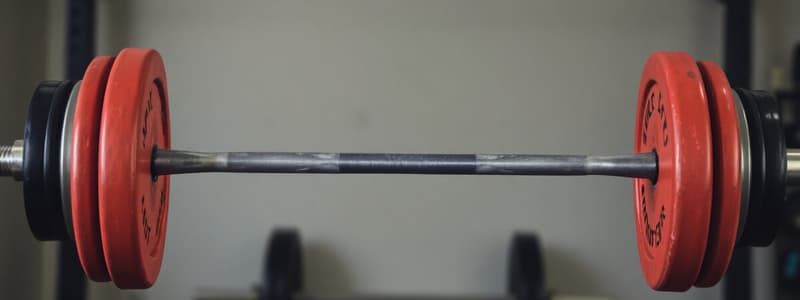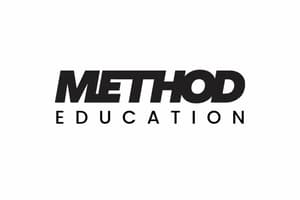Podcast
Questions and Answers
Which of the following is NOT a key consideration for weightlifting safety?
Which of the following is NOT a key consideration for weightlifting safety?
- Maximizing repetitions without breaks (correct)
- Conducting equipment checks before workouts
- Using proper form and technique
- Employing a spotter
How do warm-up routines benefit weightlifting?
How do warm-up routines benefit weightlifting?
- They decrease overall workout time
- They enhance muscle hypertrophy
- They prevent the need for cool-down routines
- They improve blood flow and flexibility (correct)
Which lifting category focuses on exercises that work multiple muscle groups at the same time?
Which lifting category focuses on exercises that work multiple muscle groups at the same time?
- Aerobic Lifts
- Isolation Lifts
- Accessory Lifts
- Compound Lifts (correct)
What is the main benefit of using proper form during weightlifting?
What is the main benefit of using proper form during weightlifting?
What is the term for the technique involving gradually increasing resistance to promote muscle growth?
What is the term for the technique involving gradually increasing resistance to promote muscle growth?
What is meant by 'range of motion' in weightlifting?
What is meant by 'range of motion' in weightlifting?
What is the role of a spotter during weightlifting?
What is the role of a spotter during weightlifting?
What is a recommended practice to enhance lifting performance besides weight management?
What is a recommended practice to enhance lifting performance besides weight management?
What does 'superset' mean in weightlifting?
What does 'superset' mean in weightlifting?
What does range of motion mean in weightlifting?
What does range of motion mean in weightlifting?
What does a 'rep' mean in weightlifting?
What does a 'rep' mean in weightlifting?
What does a set mean in weightlifting?
What does a set mean in weightlifting?
What is an accessory lift?
What is an accessory lift?
What is an example of an accessory lift?
What is an example of an accessory lift?
A squat is what type of lift?
A squat is what type of lift?
What is the term used to describe the heaviest weight you can lift?
What is the term used to describe the heaviest weight you can lift?
Which muscles are primarily responsible for the chest area?
Which muscles are primarily responsible for the chest area?
Which of the following muscles are part of the back muscles? (Select all that apply)
Which of the following muscles are part of the back muscles? (Select all that apply)
The bent over row primarily targets which muscles?
The bent over row primarily targets which muscles?
What lift primarily targets the quadriceps?
What lift primarily targets the quadriceps?
Which muscles are primarily used during pushing movements in weightlifting?
Which muscles are primarily used during pushing movements in weightlifting?
What muscles are primarily used in pulling exercises?
What muscles are primarily used in pulling exercises?
What do hip thrusts primarily target in weightlifting?
What do hip thrusts primarily target in weightlifting?
What are 5 lifts that target the quads?
What are 5 lifts that target the quads?
What are 5 lifts that target the shoulders?
What are 5 lifts that target the shoulders?
What is the proper form for a bench press?
What is the proper form for a bench press?
Describe the proper form for squatting.
Describe the proper form for squatting.
What makes your muscles sore after an exercise?
What makes your muscles sore after an exercise?
How do muscles grow?
How do muscles grow?
What does hypertrophy mean?
What does hypertrophy mean?
Which workout targets the hamstrings?
Which workout targets the hamstrings?
Flashcards
Strength
Strength
The ability to exert force, typically using muscles to lift, push, or pull objects. It is a fundamental aspect of physical fitness and can be developed through various training methods.
Powerlifting
Powerlifting
A training style focused on maximizing strength in three key lifts: the squat, bench press, and deadlift. It emphasizes lifting heavy weights for lower repetitions.
Olympic Weightlifting
Olympic Weightlifting
A type of training that combines power, speed, and explosiveness. It involves movements like the clean and jerk and snatch, focusing on achieving a maximum lift in a short period.
Bodybuilding
Bodybuilding
Signup and view all the flashcards
Strongman
Strongman
Signup and view all the flashcards
Compound Lift
Compound Lift
Signup and view all the flashcards
Accessory Lift
Accessory Lift
Signup and view all the flashcards
Rep
Rep
Signup and view all the flashcards
Set
Set
Signup and view all the flashcards
Form
Form
Signup and view all the flashcards
Range of Motion (ROM)
Range of Motion (ROM)
Signup and view all the flashcards
Warm-up
Warm-up
Signup and view all the flashcards
Cool-down
Cool-down
Signup and view all the flashcards
Study Notes
Basic Weightlifting Terminology
- Compound Lift: Exercise involving multiple muscle groups working simultaneously. Examples include squats, deadlifts, bench press, overhead press, and rows.
- Accessory Lift: Exercise targeting specific muscle groups to support compound lifts and improve overall strength and physique. Examples include bicep curls, triceps extensions, lateral raises, and hamstring curls.
- Rep: A single execution of an exercise.
- Set: A group of repetitions performed consecutively with a short break between sets.
- Form: The technique and posture used to execute an exercise correctly, emphasizing safety and efficiency.
- Range of Motion (ROM): The complete movement arc of a joint or muscle group during an exercise. Proper ROM improves effectiveness and reduces injury risk.
- Warm-up: Preparing the body for exercise by performing light cardio and dynamic stretching to increase blood flow and enhance flexibility before lifting heavy weights.
- Cool-down: Activities conducted after a workout consisting of static stretching postures to help the muscles recover, prevent soreness, and reduce the risk of injury.
- Spotter: Another individual providing assistance during exercises like deadlifts or squats to prevent injuries and ensure safety.
- Barbell: A metal bar with weights (plates) attached at each end, used in various compound lifts.
- Dumbbell: A pair of weighted, handheld implements used in exercises with focus on isolation and control.
- Plates: Circular weights attached to the barbell or dumbbells.
Weightlifting Techniques and Principles
- Progressive Overload: Gradually increasing the weight, repetitions, or sets to progressively challenge the muscles, stimulating growth and strength development.
- Specificity: Tailoring training to a particular goal or movement. This ensures that the exercises directly address the muscle groups needed.
- Variation: Employing different exercises and techniques to challenge the muscles from diverse angles, preventing plateaus and promoting holistic strength development.
- Proper Breathing: Proper breathing techniques, such as exhaling during exertion and inhaling during recovery, contribute to improved lifting performance and decrease stress on the body.
- Rest and Recovery: Adequate rest and recovery periods between workouts to allow the muscles time to repair and rebuild. Insufficient rest can lead to fatigue and injury.
- Nutrition: Proper nutrition plays a vital role in weightlifting, providing fuel for energy for exercise and recovery. Intake of essential nutrients, proteins, carbohydrates, and fats as per an individual or professional plan significantly optimizes strength and recovery.
- Safety: Prioritizing safety in all weightlifting exercises. Using proper form and technique, spotters, and equipment checks before each workout to prevent injuries.
Different Lifting Styles
- Powerlifting: Emphasis on maximal strength in three primary compound lifts: squat, bench press, and deadlift.
- Olympic Weightlifting: Focuses on speed, explosiveness, and technique in lifts like the clean and jerk, and snatch. It measures maximum potential in a shorter period.
- Bodybuilding: Prioritizes muscle hypertrophy (increase in muscle size) and aesthetic physique development. Uses a wider range of exercises targeting specific muscle groups with more emphasis on accessory lifts.
- Strongman: Features exceptionally heavy loads, unusual objects, and combinations of different strength exercises.
Weightlifting Considerations
- Warm-up routines: Essential in preparation, improving blood flow to the muscles and enhancing flexibility.
- Cool-down routines: Crucial in recovery, preventing muscle soreness after workout.
- Proper form and technique: Fundamental to achieving safe and effective results. Improper form potentially leads to injury and limits progress.
- Monitoring exertion: Pay attention to pain or unusual symptoms during workouts. Pushing to excess could cause harm.
- Medication and health conditions: Individuals with medical conditions or taking medication should consult with a healthcare professional before commencing weight training.
Studying That Suits You
Use AI to generate personalized quizzes and flashcards to suit your learning preferences.




